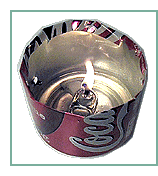button lamp

Caroline Ingalls’ improvised lantern made in a saucer during the Hard Winter of 1880-1881, using axle grease for the oil and a bit of fabric wrapped around an old button for the wick.
 [Ma] put the button in the center of the square of calico. She drew the cloth together over the button and wound a thread tightly around it and twisted the corners of calico straight upward in a tapering bunch. Then she rubbed a little axle grease up the calico and set the button into the axle grease in the saucer. -The Long Winter, Chapter 19, “Where There’s a Will”
[Ma] put the button in the center of the square of calico. She drew the cloth together over the button and wound a thread tightly around it and twisted the corners of calico straight upward in a tapering bunch. Then she rubbed a little axle grease up the calico and set the button into the axle grease in the saucer. -The Long Winter, Chapter 19, “Where There’s a Will”
 I know it’s the wrong time of year to be thinking about winter things, even though I did have to wrap myself in a blanket and wear my snowboarding hat in order to stay warm last night during the fireworks. Ah, the joys of living in Montana! Now that the fourth of July has past, it’s time for winter to think about setting in.
I know it’s the wrong time of year to be thinking about winter things, even though I did have to wrap myself in a blanket and wear my snowboarding hat in order to stay warm last night during the fireworks. Ah, the joys of living in Montana! Now that the fourth of July has past, it’s time for winter to think about setting in.
Once upon a time, I bought some axle grease and I made an honest-to-goodness button lamp. This day and age, axle grease doesn’t come in a round wooden box (wouldn’t the grease soak through the wood and make the box all nasty?), it comes in a tube that fits in your caulking gun. Saucer lamps weren’t something Caroline Ingalls was the first person to think of, any more than twisting hay was something Charles Ingalls discovered. Watching a bit of fat ignite and burn as it cooks over a fire probably suggested to some primitive civilization that the next logical step was to scoop this into a shell or onto a rock with a slight depression, making for a portable light source.
Today I found this: how to make a coke can / salad oil lamp. Same principle as the button lamp, updated for today’s modern society. All you need is an aluminum can, a piece of an old sock, and a tablespoon of cooking oil.
Take the aluminum soft-drink can and very carefully cut it in half around its equator. Wear protective gloves! Use pliers and fold about a half inch of the cut edge down inside the can and crimp in place; this makes for a safer rim. From the top half of the can, remove the “pop top” by bending it back and forth. Put the rest of the top of the can in the recycling bin.
Cut a 1-1/2 inch by 3/8 inch piece out of an old sock. Cotton sock? Polyester sock? Wool sock? I don’t know… but I’d say you can’t go wrong with cotton; polyester melts and wool stinks when burned. And you could always use an actual piece of wide flat wicking (duh, cotton), which you can buy at craft and camping stores. Twist the socking and pull it through the pop-top until about 1/4 inch sticks through.
Place the pop-top-and-sock wick in the bottom of the can, with the extra socking heading off downhill in the direction of the side of the can. Look at a coke can bottom; it’s raised in the middle.
Pour a tablespoon of salad oil (corn oil, coconut oil, olive oil, soybean oil, etc.) into the bottom well of the can. Let the wick absorb some (or rub the oil onto the wick, like Ma did). Light and enjoy. The length of the wick determines the height of the flame. If your flame is smoky, try it with less sock pulled through the tab. A tablespoon of oil should burn for three to four hours.
“You’re a wonder, Caroline,” said Pa. “It’s only a little light, but it makes all the difference.”

button lamp (TLW 19, 22; PG), see also axle grease, lamp

